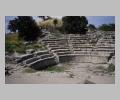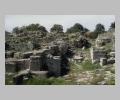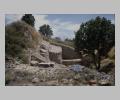
Tomb of Achilles with the Scamander valley in the background, Troy.
| Summary: | Major Late Bronze Age settlement at the Hellespont. |
| Type: | Fortified city |
| Region: | Troad |
Periods:
Early Bronze Age
Middle Bronze Age
Late Bronze Age
Archaic
Classical
Hellenistic
Roman
Physical:
From the beginning, the settlements at the site of Troy were fortified. During the Bronze Age the coast line was closer to the low mound of the site and Troy maintained a stratigic maritime advantage due to its position at the opening of the Hellespont. Troy also had access to a large fertile coastal plain for agriculture. By the Hellenistic period the coast line had shifted away due to silting and the nearby city of Alexandria Troas captured the maritime commercial advantage.
In the Early Iron Age the Greek colonists repaired and made use of the earlier Bronze Age fortification walls, and the city remained relatively small throughout the Archaic and Classical periods. In the Hellenistic period much of the original settlement area was disturbed by by the construction of a new sanctuary of Athena, a theater, palaestra, and extended city walls.
The city was destroyed in 82 B.C. during the Mithridatic Wars, but rebuilt during the reign of Augustus (27 B.C. - A.D. 14). The Roman rennovations included the reconstruction of the sanctuary of Athena and the addition of odeum, bouleuterion, and other buildings.
Description:
The earliest settlement at Troy was in the Early Bronze Age at ca. 3000 B.C. This small fortified settlement was destroyed by fire and was followed by Troy II (2500-2200 B.C.), which Schliemann incorrectly believed to have been the city of Priam. Settlement continued throughout the Bronze Age at the site. The latest prehistoric levels are Troy VI (1800-1275 B.C.) and Troy VII (1275-1100 B.C.) and scholars debate which of these levels represent the city of Priam and scene of the Trojan War.
Following the end of the Late Bronze Age there was a 400 year hiatus at the site until it was resettled at ca. 700 B.C. by Greek colonists, possibly from Lesbos or Tenedos. The Early Iron Age city (Troy VIII) was founded with the name Ilion and believed at the time to be the site of Homeric Troy. The city had little political power, but was symbolically important. It was under Persian control from the 6th century B.C. until the liberation of Asia Minor by Alexander the Great in 334 B.C.
In 480 B.C. Xerxes halted at Troy to sacrifice a thousand oxen before crossing the Hellespont into Greece. In 334 B.C. Alexander went to Troy immediately after crossing into Asia Minor to make an offering. Following the death of Alexander in 323 B.C., his successor in Thrace had a new temple of Athena built at the city. Julius Caesar, who believed himself to be a direct descendant of Priam, visited the city and gave it immunity from taxation. In the reign of Augustus the city and the sanctuary of Athena under went a large rebuilding program. Constantine considered Troy as a possible site for his new capital before chosing Byzantium, and as late as A.D. 355 the site was visited by the emperor Julian. By the 4th century A.D., however, the site was little more than a small farming community and by the 12th century A.D. it was completely abandoned.
Exploration:
Troy was discovered and first excavated by H. Schliemann at the end of the last century. Work was continued by Dörpfeld and then by C. Blegen.
Sources Used:
Other Bibliography:




